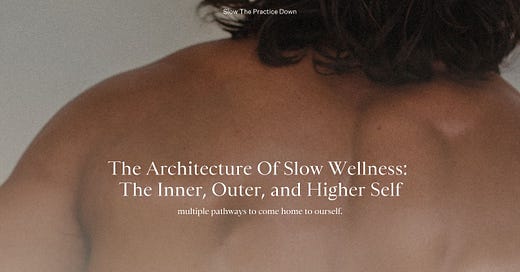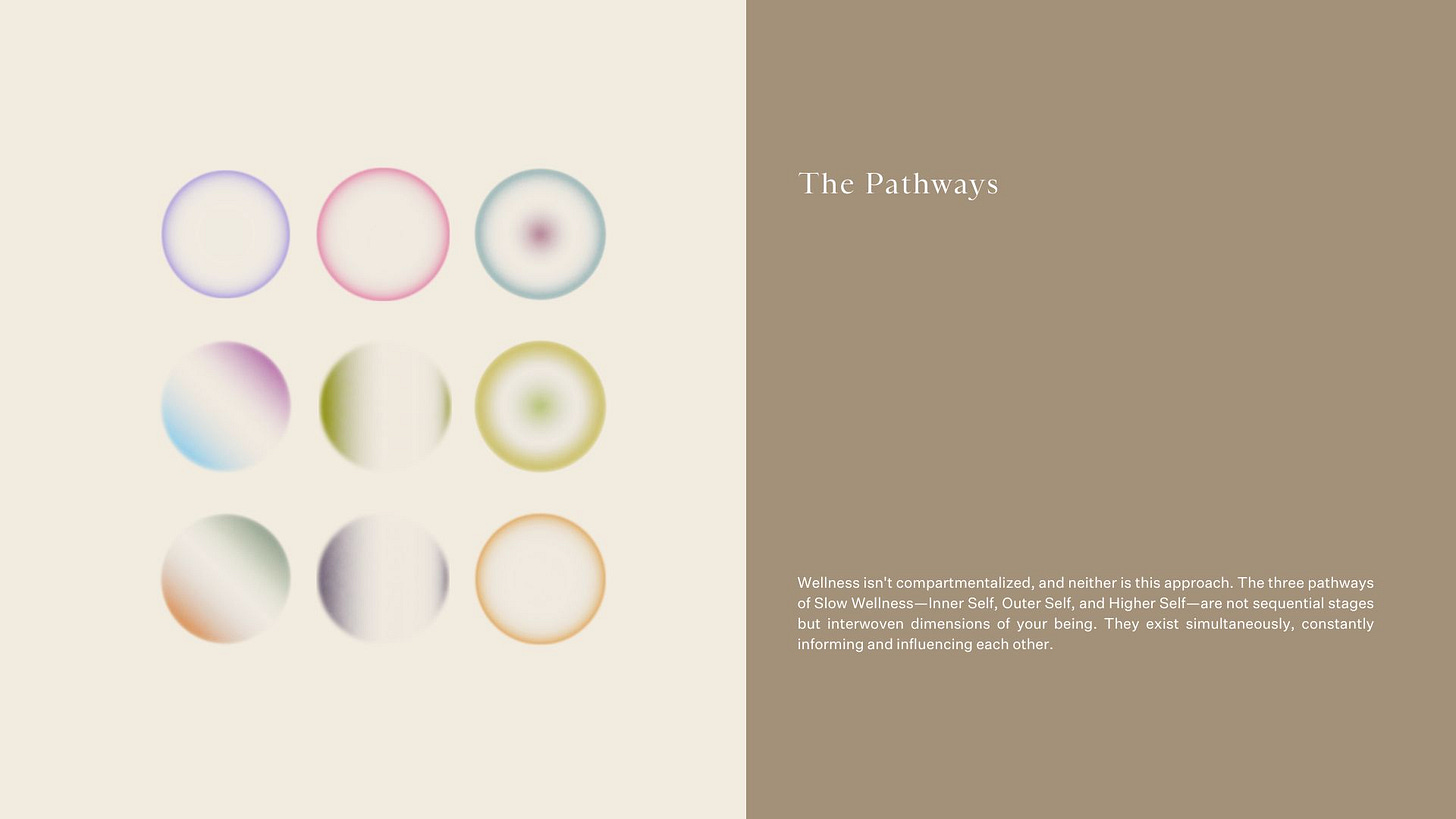The Architecture Of Slow Wellness: The Inner, Outer, and Higher Self
Pathways back to yourself.
🎧 Voice Notes from Me to You:
My close friends and I often send podcast-length voice notes to each other—it's our favorite way to share stories and stay connected. In that same spirit, here's my voice note to you! This is my way of bringing some real connection to our digital relationship. Listen for the inspiration behind this piece, some context about why it matters to me, and the thoughts that didn't make it into the written article.
Full article reading begins at 4:20 or keep scrolling and read below.
As I sit here and write this, it's almost hard to remember what the experience of crippling anxiety, low-self esteem, and depression felt like in my body.
It wasn't that long ago that I carried a prominent buzz of a dysregulated nervous system inside of me everywhere I went. But today, I can't even remember the last time I felt it to the extent I did 10 years ago.
That's not a flex.
It's just a self-acknowledgment of how much I've changed.
Back then, I was just trying to make it through the day. When I felt burned out or overwhelmed I shut down. The basics required to tend to all the needs of my mind and body felt like too much (let alone the laundry list of "should do's" highlighted in all the self-help and wellness content I was consuming).
Instead of trying to do it all. I chose to focus on one intentional act of care. And sometimes even a few...when I had the capacity.
My dedication to one action at a time was the first step down a meandering path that changed my life - not through dramatic breakthroughs but through the gentle persistence of small, daily choices.
What I didn't fully understand then, but can appreciate now, is that there's a fascinating biological basis for how my decision to center self-care in my life reshaped the neural pathways in my brain and ultimately transformed my mind and my self-relationship. I was activating what neuroscientists call experience-dependent neuroplasticity.
Simply put - I cared-for and tuned into my body and my mind eventually caught up. This is the basis of somatic healing work. The neural pathways associated with my anxiety became less dominant, and new pathways linked to self-compassion and well-being strengthened.
This understanding - that transformation happens through consistent, gentle practices rather than dramatic overhauls - became the foundation for what I now call Slow Wellness and its pillars I call pathways.
The Three Pathways of Slow Wellness: A New Model For Authentic Self Care
This understanding of gradual neural transformation led me to develop the pathways of slow wellness. I organized these into three interconnected realms: inner, outer, and higher self-care.
While they may echo the familiar (and a little outdated) mind-body-spirit framework, I found that there was an opportunity to better capture the nuanced ways different aspects of ourselves communicate with and influence each other.
Inner self-care focuses on our internal landscape. When we practice inner self care, we tend to our thoughts, feelings, and our nervous system, and the subtle energetic communication between mind and body. This is where we cultivate our relationship with ourselves.
Outer self-care focuses on our physical needs, our sensory awareness, and relational health (or co-regulation). This pathway deepens our sense of embodiment and connection with ourselves and others while tending to our physical body and engaging our senses to help ground us in the present moment. Through outer self-care, we learn to feel at home in our bodies.
Higher self-care explores our connection to something greater. This includes spiritual hygiene, alignment, purpose, intuitive wisdom, and the expansive perspectives that emerge when we transcend limited thinking.
What makes these pathways powerful is their interconnection. When we engage with any one pathway consistently, we create subtle ripples through the others.
So that single act of care I mentioned earlier? It was never a superficial act of self-care. It was initiating a quiet revolution across all three pathways.
Why Pathways?
I chose the word pathway for two reasons:
One is poetic. One is biological.
Metaphorically, healing is a path that is not linear.
It's not a race. There are no stages. Nor a single destination. It’s a spiral, not a straight line...a journey we return to again and again, each time with a little more wisdom in our step.
Pathway is also a biological term.
In the brain, neural pathways are like trails carved by repetition. Every time you practice something (like deep breathing, setting a boundary, or speaking kindly to yourself), you strengthen the connection between brain cells. Over time, these same practices become automatic. It's like walking a path our future self will find easier to return to.
This process is called neuroplasticity. It's the brain’s ability to rewire itself through experience. It doesn’t require perfection or intensity to do this. Only consistency and intentionality.
As we practice even the smallest acts of slow and intentional care, we are literally building new internal architecture. In wellness speak, we call that transformation.
I'll dive deeper into each pathway, but for now, in your own experience, what pathway in your life is asking for your attention and care in this moment?
Can you choose one action to tend to its needs... and let that be enough?
Go slow.
Melissa




